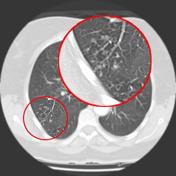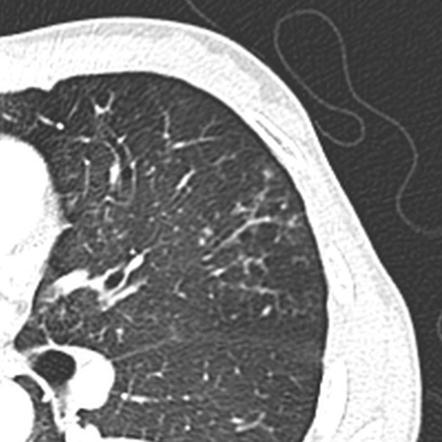tree in bud lesion
The tree-in-bud pattern occurs commonly in patients with endobronchial spread of Mycobacterium tuberculosis and is highly suggestive of active tuberculosis 2 3. Bud measures 12 mm in diameter and is definitely bigger than parent bronchiole tree.

Co Rads 2 With Tree In Bud Sign A 27 Year Old Male Attended The Download Scientific Diagram
It consists of centrilobular branching opacities with or without centrilobular nodules or thickened interlobular septa.

. The purpose of this study was to determine the relative frequency of causes of TIB opacities and identify patterns of disease associated with TIB opacities. There are no criteria for invasion of the aorta or the bronchial tree. High-resolution computed tomography of the chest HRCT plays an outstanding role in PLCH diagnosis.
We investigated the pathological basis of the tree-in-bud lesion by reviewing the pathological specimens of bronchograms of normal lungs and contract radiographs of the post-mortem lungs manifesting active pulmonary tuberculosis. Tree-in bud is the first sign detectable in asymptomatic people is characteristic of expanding lesions and disappears with effective therapy 31. Slice thickness is 1 mm.
Aims of this retrospective descriptive multi-center study were to characterize the CT appearance of a tree-in-bud pattern in a group of cats and compare this pattern with radiographic and clinical findings. The tree-in-bud-pattern of images on thin-section lung CT is defined by centrilobular branching structures that resemble a budding tree. With the literature on tree-in-bud investigators since the 1850s have identified obstructive lobular pneumonia as the characteristic lesion of developing post-primary TB.
Tree-in-bud refers to small airway at the bronchiole level involvement of lesions resulting in expansion of the airway and infiltration of pathological substances into the tube cavities which manifests as nodular shadows of diameter of 24 mm and branch line shadows connected with these nodules in thin layer CT which look like tree-in-buds. We investigated the pathological basis of the tree-in-bud lesion by reviewing the pathological specimens of bronchograms of normal lungs and contract radiographs of the post-mortem lungs manifesting active. PV pulmonary vein.
Centrilobular nodules with a linear branching pattern are consistent with tree-in-bud appearance in a patient with endobronchial spreading of post-primary tuberculosis. Mycobacterium avium complex is the most common cause in most series. However to our knowledge the relative frequencies of the causes have not been evaluated.
The remaining pulmonary parenchyma demonstrated scattered tree-in-bud pattern with lower lobe predominance and without pleural effusion. 1 It is important for clinicians to remember that this pattern has an extensive. It is not specific for a single disease entity but is a direct sign of various diseases of the peripheral airways and an indirect sign of bronchiolar diseases such as air trapping or sub-segmental consolidation.
The tree-in-bud sign indicates bronchiolar luminal impaction with mucus pus or fluid causing normally invisible peripheral airways to become visible 80. High-resolution CT usually reveals small 24-mm centrilobular nodules and branching linear opacities of similar caliber originating from a single stalk Figs 2 3 4. Lymph node involvement at the carina level were noted.
Tree-in-bud TIB is a radiologic pattern seen on high-resolution chest CT reflecting bronchiolar mucoid impaction occasionally with additional involvement of adjacent alveoli. The tree-in-bud sign could be seen in various infectious diseases including endobronchial spread of tuberculosis bacterial viral parasitic and fungal. The tree-in-bud sign on thin-section CT is characterized by well-defined small centrilobular nodules and linear opacities with multiple branching sites thus resembling a budding tree in spring.
The tree-in-bud-pattern of images on thin-section lung CT is defined by centrilobular branching structures that resemble a budding tree. In humans a CT tree-in-bud pattern has been described as a characteristic of centrilobular bronchiolar dilation with bronchiolar plugging by mucus pus or fluid. The patient had an oesophageal lesion below the carina extending longitudinally 6 cm.
3 Aspiration is also a common cause of the tree-in-bud formation. Multiple causes for tree-in-bud TIB opacities have been reported. 2 However the classic cause of tree-in-bud is Mycobacterium tuberculosis especially when it is active and contagious and associated with cavitary lesions.
1 2 3 4 reported causes include infections aspiration and a variety of inflammatory conditions. Definition of tree in bud tib on ct. Aims of this retrospective descriptive multicenter study were to characterize the CT appearance of a treeinbud pattern in a group of cats and compare this pattern with radiographic and clinical findings.
The typical radiological picture of PLCH is the presence of small intralobular nodules often forming tree in bud lesions cavitated nodules thin- and thick-walled cystic lesions frequently confluent. Post-mortem radiograph of patient with active pulmonary tuberculosis demonstrating tree-in-bud lesion boxed area with smooth marginated bronchiole tree and distal clubbed end bud. In humans a CT treeinbud pattern has been described as a characteristic of centrilobular bronchiolar dilation with bronchiolar plugging by mucus pus or fluid.

Tree In Bud Sign Lung Radiology Reference Article Radiopaedia Org

References In Causes And Imaging Patterns Of Tree In Bud Opacities Chest

Tree In Bud Sign Lung Radiology Reference Article Radiopaedia Org
View Of Tree In Bud The Southwest Respiratory And Critical Care Chronicles

Tree In Bud Sign Marking Advancing Cavitary Tb A 4 Mm Coronal Ct Download Scientific Diagram

Cylindrical Bronchiectasis And Tree In Bud Pattern In Lower Lobes And Download Scientific Diagram

Tree In Bud Sign Lung Radiology Reference Article Radiopaedia Org